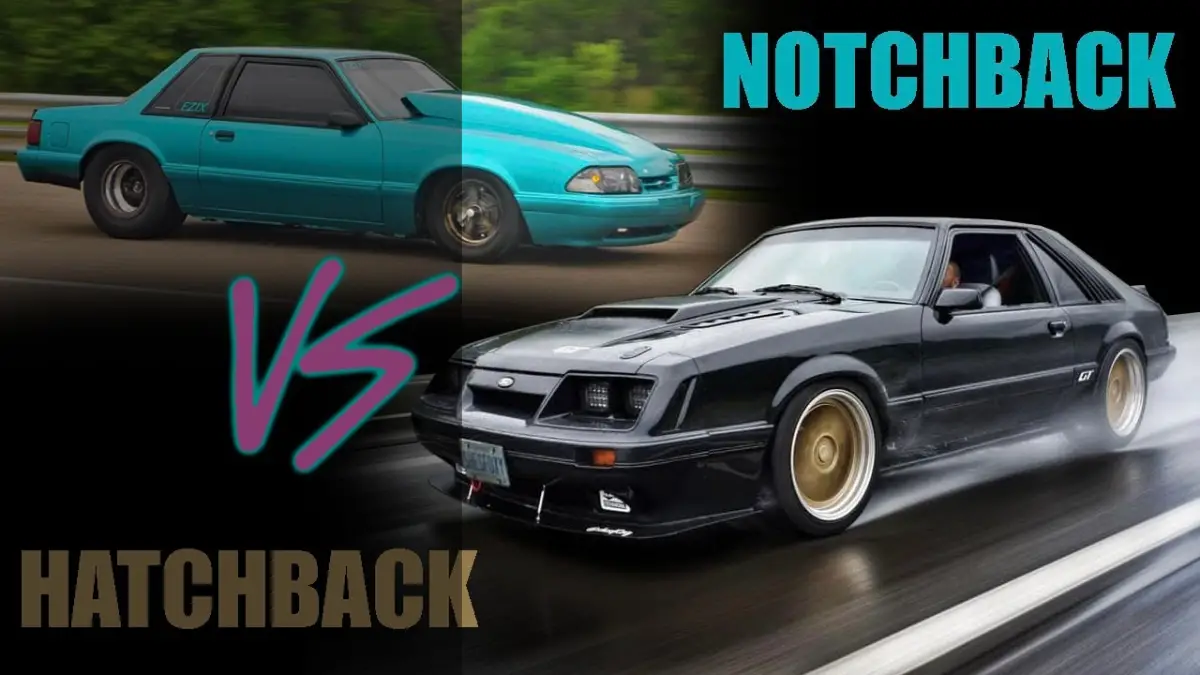Notchback or Hatchback? These two distinctive styles of the classic American muscle car have their own unique appeals and characteristics.
In this article, we’ll take a look into the differences between the Notchback and Hatchback Fox Body Mustangs, exploring their histories, designs, performance, and potential for customization.
The History of Notchback and Hatchback Fox Bodies
The Birth of the Fox Body
The Fox Body Mustang, produced between 1979 and 1993, is the third generation of Ford’s legendary muscle car. The term “Fox Body” stems from the platform it was built on, the Fox platform, which was used in various Ford models during this era.
Notchback: A Nod to the Past
Notchback cars are something between the hatchback and sedan. Notchback is a sedan with a separate trunk compartment.
The Notchback model features a traditional trunk design, reminiscent of the earlier Mustang generations. This design was popular among those who preferred a more classic appearance for their muscle car.
Hatchback: Modern Versatility
Hatchback cars are identified by a rear door, including the back window that opens to access a storage area that is not separated from the rest of the passenger compartment.
The Hatchback was designed to cater to those who sought a more modern, versatile vehicle. This model features a rear hatch for easy access to the cargo area, giving the car a sleeker, more contemporary look.
Design and Aesthetics
Notchback: Classic and Elegant
The Notchback boasts a more formal, elegant profile with its traditional trunk and rear window design. Many enthusiasts appreciate the Notchback’s classic silhouette, which is reminiscent of the first-generation Mustangs.
Hatchback: Sporty and Practical
The Hatchback Fox Body presents a sportier and more aerodynamic profile. Its design is both stylish and functional, offering increased cargo space and easy access through the rear hatch. This model is often preferred by those who require additional utility from their muscle car.
Performance and Weight Differences
Lighter Notchback: A Performance Advantage
One key difference between the two models is weight. The Notchback is generally lighter than the Hatchback, which can translate to improved performance on the street or track. This weight advantage has made the Notchback a popular choice among racers and performance enthusiasts.
Hatchback: A Well-Balanced Ride
While the Hatchback is slightly heavier, it benefits from a more balanced weight distribution due to the rear hatch design. This can provide a more predictable and stable driving experience, especially during spirited driving or on curvy roads.
Customization and Aftermarket Support
Notchback: A Blank Canvas
The Notchback’s simpler design offers a clean canvas for those looking to customize their Fox Body. Many aftermarket parts are available to enhance the appearance and performance of the Notchback, making it an attractive option for those with a specific vision for their car.
Hatchback: Endless Possibilities
The Hatchback also enjoys extensive aftermarket support, with numerous options to improve its look, performance, and functionality. The additional cargo space of the Hatchback allows for more creative customization, such as audio system upgrades or even a rear-seat delete for a more track-focused build.
Conclusion
Both the Notchback and Hatchback Fox Body Mustangs have their unique appeals, and the decision ultimately comes down to personal preference. If you’re a fan of the classic Mustang look and are seeking a lighter, more performance-oriented vehicle, the Notchback might be the right choice for you.
On the other hand, if you appreciate a more modern design with added versatility and cargo space, the Hatchback could be your ideal Fox Body. Regardless of the model you choose, both the Notchback and Hatchback offer a fantastic base for customization and performance upgrades, ensuring you’ll have a unique and enjoyable ride.
Before making a decision, it’s essential to consider your specific needs and preferences. Test drive both models, if possible, and consult with fellow enthusiasts or online forums to gain more insight into the pros and cons of each Fox Body style.
FAQs
- How does the weight of the Notchback compare to the Hatchback? The Notchback Fox Body is generally lighter than the Hatchback, providing a performance advantage due to reduced weight. This makes it a popular choice among racers and performance enthusiasts.
- Is there a difference in aftermarket support between the Notchback and Hatchback Fox Bodies? Both the Notchback and Hatchback enjoy extensive aftermarket support, with a wide variety of parts and accessories available for customization. The choice between the two models often comes down to personal preference and the specific vision an owner has for their car.
- Which Fox Body model is better for daily driving? While both models can be suitable for daily driving, the Hatchback might be a more practical option due to its increased cargo space and rear hatch access. However, this ultimately depends on an individual’s needs and preferences.
- Are there significant differences in performance between the Notchback and Hatchback?While the Notchback’s lighter weight can provide a performance advantage, the Hatchback benefits from a more balanced weight distribution. In general, the performance differences between the two models are relatively minor, and both can be modified and upgraded for improved performance.


